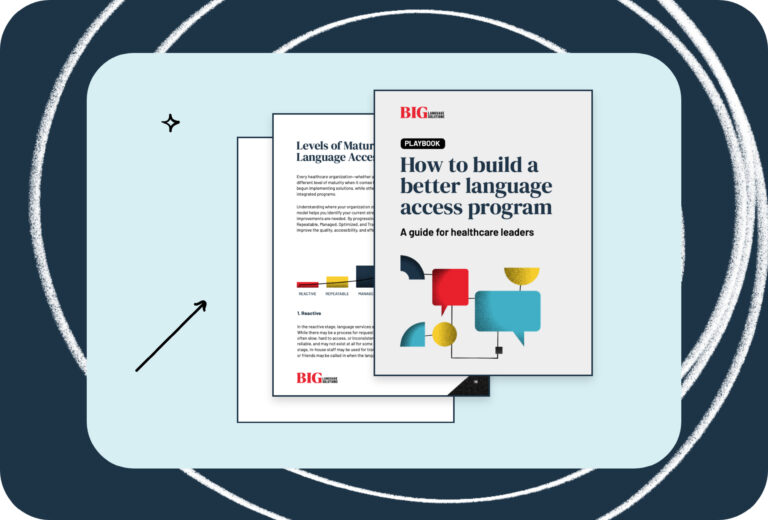Good communication is the foundation of effective medical diagnosis, treatment, and prevention. Yet providers are also under tremendous time pressure, and getting an interpreter or requesting a translation adds an extra step. At first glance, Google Translate seems like a tempting solution. Real-time translation into hundreds of languages for free at the press of a button? Yes, please! In reality, however, this quick fix is neither safe nor suitable for critical medical conversations. It works great in restaurants but not in medical settings: Doctors need solutions that guarantee accuracy and security, and Google Translate simply isn’t built for that.
From patient safety to legal concerns, here are five key reasons why doctors should avoid relying on this tool—and smarter alternatives that help you overcome language barriers without the dangers of Google Translate in healthcare.

- Google Translate does not protect private information
Healthcare providers are legally bound by the Health Insurance Portability and Accountability Act (HIPAA), which sets strict standards to protect sensitive patient information. Unfortunately, you only have to read the terms and conditions to see that Google Translate doesn’t meet these standards.
The platform not only collects the data you enter to improve its services but also retains the right to reproduce, modify, and even publish that content. This means any confidential patient information—names, diagnoses, treatments—entered into the tool is at risk of being exposed or misused, or used to train the artificial intelligence (AI) that powers Google Translate.
In fact, Google explicitly states that users grant them permission to store and use the data input. That’s a clear violation of HIPAA’s privacy standards, putting providers at risk for hefty fines, legal liabilities, and reputational damage.
Beyond the HIPAA problems, recent changes to Section 1557 of the Affordable Care Act (ACA) require healthcare providers who provide Medicare or Medicaid to offer language access services that are accurate, timely, and protect patient privacy. This means that only qualified interpreters or translators can handle critical medical information. If machine translation is used, it must be reviewed by a qualified human translator in important contexts. Relying solely on AI or machine translation for critical communication violates these regulations, exposing healthcare organizations to compliance risks and legal penalties. - Google Translate doesn’t have “soft skills”
For face-to-face conversations, nonverbal communication and emotional perceptiveness are important. This is especially crucial when those conversations are about serious matters like a person’s health. It takes emotional intelligence to read the facial expressions, body language, and tones of voice of the people involved. Cultural differences add another level of complexity, affecting how people communicate, how they display their emotions, and they prefer to discuss sensitive topics.
Human interpreters have the experience, training, and cultural competency to navigate this emotional landscape and deliver information appropriately. Google Translate does not have these human skills.
Plus, can you imagine having medical news about yourself or a loved one spoken in the same automated voice you’ve come to expect from your GPS app? Or reading it on a screen? From the patient perspective, Google Translate can make situations that are already alarming and confusing even more so. Professional interpreters, on the other hand, have been shown in studies to improve patient satisfaction - Google Translate is not a specialized medical translation service
Medical terminology is complex and highly specialized. Free, public MT tools like Google Translate are built for a general audience, which means that it is not equipped to deal with any type of specialized language, especially if the target language for translation is a low-resource language. There is a high risk of translation errors.
For example, a 2024 comparison of Google Translate, ChatGPT, and translations from professional translators found that while Google Translate and ChatGPT performed similarly to professional translators when translating discharge instructions into Spanish and Brazilian Portuguese, “ChatGPT and Google Translate had more of what the evaluators considered “potentially clinically significant errors” in Haitian Creole.
Incorporating terminology glossaries and translation memories can improve accuracy with specialized language, but this option is not available on free, public MT engines like Google Translate.
For critical healthcare conversations, you need reliable, consistent communication. Professional interpreters and translators use tools like glossaries and translation memories so that terms get translated accurately every time. - Google Translate is inconsistent
One of the biggest issues with Google Translate is its lack of consistency. The same word or phrase can be translated differently depending on the surrounding text, which can create confusion—especially with isolated terms or short sentences that can be common in medical settings.
It also struggles with regional dialects. A medical term that makes sense in Spain might be confusing for a patient in Mexico or Argentina. Google Translate doesn’t always catch these subtle but important differences, which can lead to misunderstandings in patient care.
Then there’s sentence structure. Longer or more complex instructions—like treatment plans—can end up being mistranslated if the sentence phrasing is even slightly altered. These inconsistencies make it hard to rely on the tool for accurate communication, especially when patient safety is at stake.
Only a professionally trained translator can ensure consistency. - Google Translate is too risky to substitute for medical interpreting services
Machine translation can be used to speed up medical translations with appropriate quality assurance (QA) steps in place. But when you’re relying on Google Translate for real-time translations, there isn’t time for quality control and revisions to fix translation errors. And that introduces an unacceptable level of risk.
For example, a 2019 evaluation found that “2% of Spanish and 8% of Chinese sentence translations had potential for significant harm” when Google Translate was used to translate discharge instructions. When a patient’s health is on the line, you need solutions that prioritize patient safety, like professional interpreters who deliver accurate, real-time communication without the guesswork. This level of professional translation has been shown to improve clinical care.

What to Do Instead: Partner with a Language Services Provider (LSP) for Medical Translation and Interpreting Services
When language barriers arise, healthcare providers need accurate, private, and reliable solutions. Machine translation and AI do have a role to play in language access for healthcare, but not in the context of most patient conversations.
Instead of relying on risky tools like Google Translate, BIG Language Solutions offers over-the-phone interpreting (OPI), connecting you to professional medical interpreters in 20 seconds or less, in over 300 languages, available 24/7. Whether it’s a routine consultation or an urgent situation, OPI provides accurate, real-time communication in seconds, with 99.999% uptime thanks to an extensive and reliable telephony structure. We also use AI-powered call analysis for quality assurance, to drive compliance and help our interpreters further refine their skills.
For document translation, LanguageExpress™ delivers fast turnaround times and scalability, combining custom workflows and machine translation with human post-editing for dependable, accurate results. From discharge instructions to EOBs, LanguageExpress™ gets your documents translated quickly and correctly—without sacrificing quality. Both solutions are HIPAA-compliant, keeping communication clear, secure, and fully aligned with regulations.
Reliable Language Solutions for Better Patient Care
In healthcare settings, accurate and clear communication is essential to providing safe, effective care. While tools like Google Translate might seem like the easiest, fastest, and cheapest way to communicate with patients who need language assistance, they introduce too many risks, from patient safety concerns to regulatory violations. Healthcare providers need solutions that offer accuracy, consistency, and security.
Professional interpreters and translation services, like those offered by BIG Language Solutions, help overcome language barriers without compromising patient care or compliance. Contact us at [email protected] to talk about the best approach to multilingual communication for your clinic or office.






